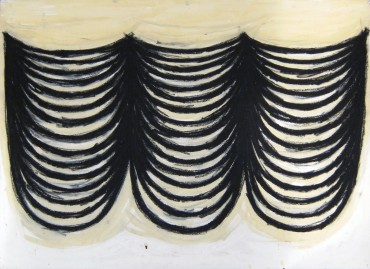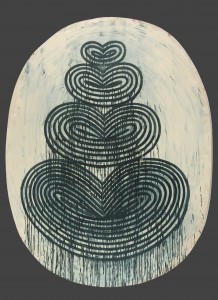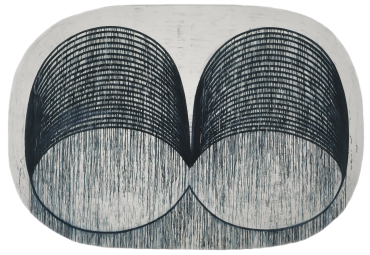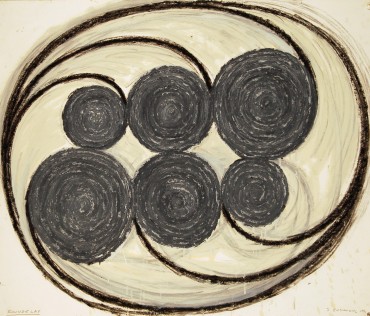An interview with Steve Cushner, as he prepares for his new exhibition, The Shaped Paintings, 1991-1993 at Hemphill Gallery in Washington, DC opening on Saturday, January 12 6:00–8:00pm.
Introduction by Dan Treado, curator of All My Friends Are Painters, a group show that included Steve Cushner in Summer 2012.
When I put together All My Friends are Painters, I wanted to peer inside the hermetic practice of a so-called “painter’s painter.” Steve certainly qualifies as one. He’s a painter who puts his head down and makes a ton of work, and that work continues to be challenging in a uniquely enthralling way that is especially resonant with other painters. He does what he sets out to do, and he does it convincingly, unflinchingly, and it’s been a lot of fun watching it happen. The climate (and art market) here in DC is such that the painter realizes that no one here really needs paintings, and so of course the benefit of that is freedom — freedom to chart one’s own path and pursue work that may not be entirely profitable. – Dan Treado
Introduction by Cara Ober, a former student of Steve Cushner at American University in the 1990’s.
Examining the images for this exhibit I am struck by how au courant these twenty-year-old paintings feel, in an age where droves of young, Stockholder-influenced painters break the flat cube in all manner of ways. According to Hemphill Gallery, “When the shaped paintings were first shown, the reception was not warm. In the mid 1990s the paintings were removed from their stretchers, rolled and stored.” Unlike Cushner’s later bodies of work, exploring abstraction with a much wider color palette and rectangular formats, the shaped paintings also possess a primal, semaphoric mode of communication, another signpost of post-modern artists of the right now. Functioning as semiotic runes, there is a ruthlessness to these works, a raw power that manages to allude to ancient magic and contemporary algorhythms.
Although they were not understood or appreciated at the time they were made, these works speak volumes about art trends and the value of creating unfashionable works, of keeping ones head in the studio and creating works we don’t understand. Now that they are, oddly, in vogue, the timing seems perfect to resurrect Cushner’s shaped paintings and bring them into a contemporary dialogue, and also to celebrate a twenty-year anniversary and relationship with Hemphill Gallery. – Cara Ober
Cara Ober: How did you come to make shaped canvasses? How did you choose the shapes? Do you have any ‘mentor artists’ whose work influenced you in this direction? What do you think of Elizabeth Murray?
Steve Cushner: If I think about how I came to think about, to play with the format of painting, there were a number of thoughts and ideas that at some point came together. As a kid, I spent a lot of time visiting the contemporary collection of the Cleveland Museum of Art, and there were three pieces that I was really interested in. One was a monochromatic, geometric relief by Ben Nicholson, a small wooden construction by Jean Arp, and a soft drum set by Claus Oldenberg. This was the late 60’s – I was also looking at all of the Pop artists, particularly early Tom Wesselman, when he was combining real objects, photo collage, and painted elements. As a young artist, I did my own rip-offs of these, piecing together multiple canvasses to create unusual shapes, adding three-dimensional objects, things like that.
SC: By the time I got to RISD in 1972, many thought that painting was dead, so our conversations centered on what painting could be if it wasn’t what painting had been – flat, rectilinear, a picture of something. Since these types of paintings were no longer vital, we never really learned how to paint; we learned to think about painting, to question and challenge painting, to think about the painting as a thing, an object, not a picture of a thing. As young, egotistical, subversive artists (and the definition of an artist for us began and ended with subversive), we also believed it was our job, responsibility, and requirement to create a new kind of painting. And this kind of painting was in the air – Frank Stella, Elizabeth Murray, Sam Gilliam, who I had the opportunity to study with.
SC: I began building and decorating my own frames, cutting up and rearranging my canvasses, taking them off the stretchers, collaging them back together, working from the inside out the way a sculptor might. This seemed to me to be a new way to think about painting – it eliminated the possibility of illusion and illusionistic painting, and seemed to remove any limitations. This is why someone like Elizabeth Murray is a touchstone for many painters of my generation – she could do anything – be serious, be goofy, include imagery if she needed, could just push paint for the sheer physical joy of it.
CO: Can you talk about “Less is More” as a standard operating process? To me, this is what the work of so many young artists is missing, and a personal challenge as well. When you limit your practice to fewer options, what opens up for you? How do you decide which elements to keep and which to let go of? Is this decision making process arbitrary or based on personal convictions?
SC: I believe this question really gets at a generational shift in thinking. I caught the tail end of the abstract expressionist myth that painting was a compulsion – “a need, not a choice,” maybe defined as ” I have to.” What followed was a change in thinking, maybe defined as “Why not? Whatever.” So, yes, there are convictions that I hold on to very tightly. This is my nature. I believe that painting is an activity, a physical activity. I believe that paint is a material, and that painting’s materiality defines it – all visual images are not the same – a painting is a painting). The paint, the canvas, the brush – that’s it. I also believe that painting is quite self-expressive – each painting captures the person as well as the artist. I am monogamous – same wife, same home, same studio, same job, same friends, same activities – I am endlessly repetitive. These are limitations, but within these limits I know that I have found, and so believe I will continue to find – surprise, challenge, friction, boredom, expression, comfort.
CO: What are your visual influences? Your works have a primal quality, a power steeped in simple patterns that seem both ancient and modern-industrial. Do you look at outside influences to create your imagery or does it come from your mind?
SC: After 40 years of painting, there are so many threads woven together that it is hard to untangle them. I am certainly driven by my beliefs in what painting can be or can do. I am still influenced by the thoughts and feelings I had as a young artist, and I am influenced by all of the new ideas that I have bumped into – that painting can challenge and surprise, that it can express thought and feeling (through color, gesture, image), that it can wrestle with the history of painting, that it can entertain. So, I guess these are my visual influences – I want my paintings to be a record of a gesture, a physical activity; I want them to hint at something concrete in the world; I want them to capture my feelings about these things in the world; I hope that they can get in the ring with every other painting and hold their own; and I hope that they can delight, entertain, and challenge the viewer.
CO: Can you respond to any ideas this quote brings out for you? It’s from Dan Treado’s curatorial statement.
“A certain descriptor might apply to most of them, even: that of being a “painter’s painter.” It’s a curious turn of phrase; it usually refers to an artist who is respected by peers as a supreme executor of craft with a distinctly personal body of work, and also as a thinker who is thoroughly engaged in thinking about the problem of painting. The term also describes someone who is not afraid to make work that feels a little argumentative — and as such, advances a viewpoint about how that artist wants the world to look and feel. For the most part, these painters have committed themselves to inventing and exploring abstract systems and organic structures in which the equally inventive handling of paint is a significant part of the work.”
CO: I guess I am interested in this show b/c it illuminates what seems like a supportive community of painters in DC, also a commitment to a method of working that seems steeped in the practice of painting, long-term, regardless of the art market or fashion.
SC: I liked this quote a lot, as I think it does describe a lot of the painting that goes on in DC. There have always been a number of artists who embrace the activity of painting – paint as the material, canvas as the surface, the brush as the tool, and the activity of making the painting being the arena for discovery – thinking through the activity of painting, thinking with the brush in your hand. Maybe there is also a belief that painting is a private activity, one that happens in the studio, knowing that others are also working hard in their studios. I am sure that this kind of community exists elsewhere, but I think DC encourages this kind of thinking.
SC: Painting is seen as a serious activity, and the painting that happens here feels like part of a bigger conversation, but there is no market pressure here – no one needs these paintings, so painters are free to develop at their own pace and in their own way, and since there is no market to work towards, to satisfy, or to hustle, there is little career competition between painters. All this is for the good. I also know that I have learned so much more from painter friends than from any museum exhibition or history lesson. I have learned to work hard and to work every day. I have learned to look at and see as much as possible. And I have learned to have an open attitude – to avoid preconception, to deal with the painting as it is – what it is, not only what you want it to be.
CO: How long have you worked with Hemphill? How has the relationship with the gallery encouraged, influenced, or helped you over the years? How has your relationship evolved over time?
SC: George Hemphill opened his gallery 20 years ago, and I have been working with him and showing with him from the beginning, and we have been friends for 30 years. From the beginning, I think that there has been an understanding that this is a long-term relationship (and if you look at the history of the gallery, you will see that this is true of almost all of the artists that George has worked with).
SC: My understanding has always been that this is a partnership – my responsibility is to work hard and to be serious about what I do, and George’s responsibility is to exhibit, promote, take care of the business stuff (so I don’t need to worry about what I am not good at), and to work hard and seriously at this – all of which he has done. This is a great support – I know that there is someone who believes in what I do and understands the ups and downs of working in the studio – the good days, the bad paintings, the false starts. I have worked with other galleries (as most artists have), and this is not the typical experience, and I feel quite fortunate to have this relationship and am very thankful for the experience. All of this explains why we would choose to show these paintings now – they are part of my history, part of the history of the gallery, and illustrate not only the relationship that George and I have, but also says a lot about George as a person.
CO: I know this new exhibit at Hemphill is of older work – but first of all I have to admit I was really intrigued by the image from the show ‘All My Friends Are Painters’ at A/R this past summer. (It was called UNTANGLED, 2010, acrylic on canvas, 53 x 46 inches.) It seems a real departure from the works I knew by you – mainly by its use of color and an allover composition. Is this a new direction for you? How long have you been working this way? Or do you tend to work in a number of different directions at a time?
SC: Thanks for your comments about this painting. I don’t know that this is a departure, as the majority of my paintings follow themes and variations – images and ideas are revisited many times. This particular motif has many precedents – perhaps an image of a net or a cats cradle (two ideas that I have played with many times), perhaps the idea of traveling up and down hill through a landscape (another idea that I have played with), perhaps the feeling that an idea (or a painting, or a canvas) can unravel? My use of color has changed a few times over the years – at times it seems unnecessary, at times it is essential, at times I go way over the top.
Steven Cushner: The Shaped Paintings will be up January 12 – March 9, 2013
HEMPHILL
1515 14th Street NW
Washington DC, 20005
www.hemphillfinearts.com











